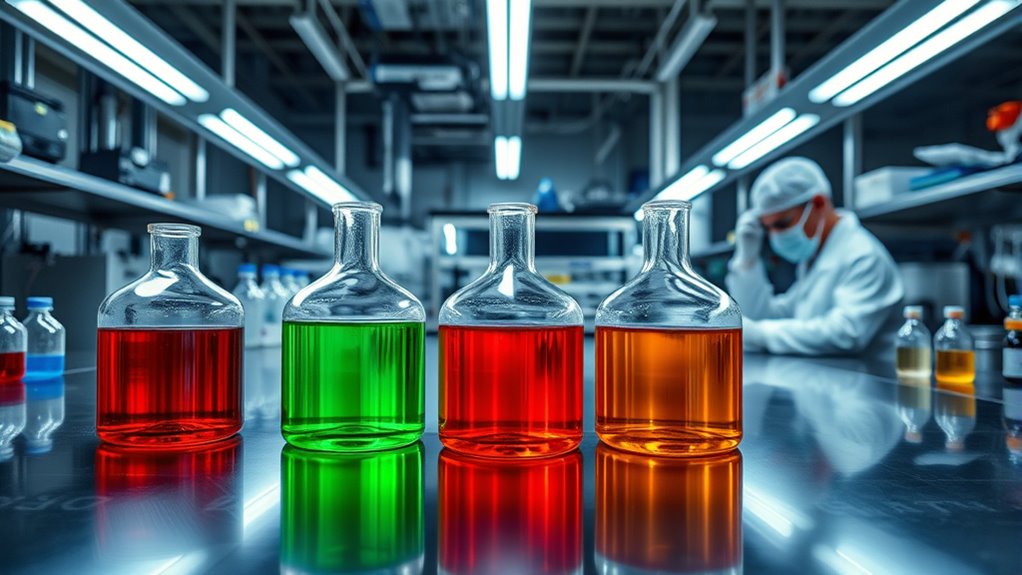As the EV battery boom advances, you see the chemical industry adapting quickly, developing new chemistries like LFP and NMC that demand massive raw materials such as lithium, cobalt, and nickel. This fuels supply chain challenges and pushes for innovative, ethical sourcing methods. Chemical companies play a key role in improving battery performance with new materials and sustainable processes. Exploring further reveals how technological breakthroughs and market shifts are shaping a greener, more responsible future for mobility.
Key Takeaways
- Shifts from lead-acid to advanced lithium-ion chemistries increase demand for critical raw materials like lithium, cobalt, and nickel.
- The industry develops innovative electrolytes and composite materials to improve battery safety, energy density, and lifespan.
- Supply chain challenges and ethical sourcing pressures drive the adoption of recycling, alternative materials, and cobalt-free chemistries.
- Advancements in graphene, carbon nanotubes, and fast-charging technologies are transforming battery performance and market competitiveness.
- Sustainability efforts in sourcing and manufacturing are shaping chemical industry practices to support cleaner, responsible EV battery production.
Evolving Battery Chemistries and Their Material Demands
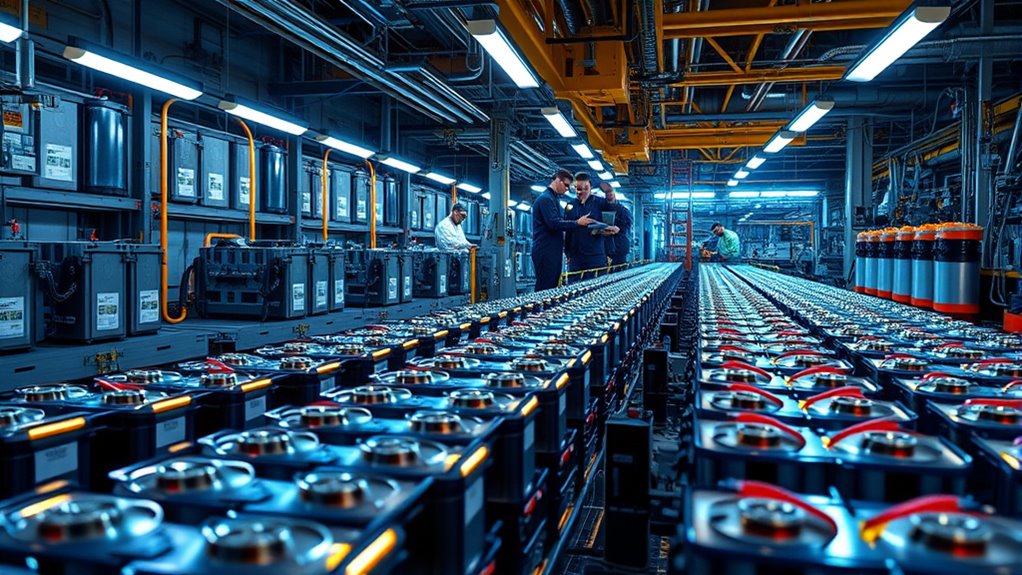
As battery chemistries evolve, the materials required for manufacturing electric vehicle (EV) batteries are shifting considerably. You’ve seen the shift from heavy, low-energy lead-acid batteries to lighter lithium-ion options. Early lithium-ion batteries used lithium cobalt oxide (LCO) for high energy density, but concerns over cost and safety led to the adoption of lithium iron phosphate (LFP), which offers better safety and affordability. Around 2008, nickel-manganese-cobalt (NMC) chemistries gained popularity for their higher energy capacity. Today, the focus is on reducing cobalt use, increasing LFP adoption, and exploring new chemistries like LMFP. These changes drive demand for raw materials like lithium, nickel, manganese, and iron, markedly impacting supply chains and material sourcing strategies. Global demand for lithium and cobalt has surged as the industry shifts toward more sustainable and cost-effective chemistries, highlighting the importance of raw material availability for future growth.
The Chemical Sector’s Role in Enhancing Battery Performance
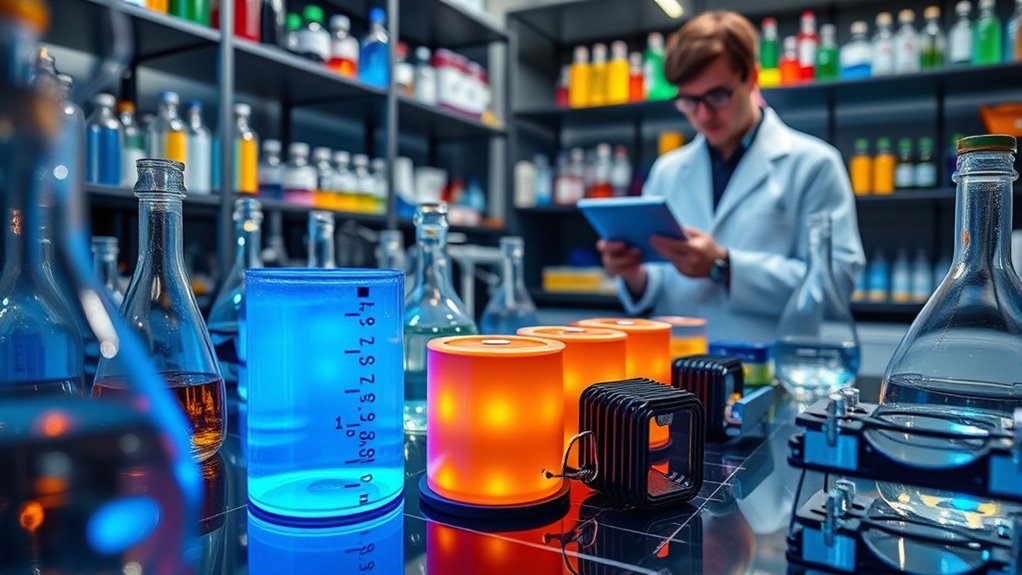
The chemical sector plays a crucial role in advancing battery performance by developing innovative materials and optimizing manufacturing processes. You’ll find chemical companies creating new composite materials and graphene additives to boost energy density and charge rates. They focus on refining electrode designs to improve efficiency and lifespan. Chemical engineers are also exploring new electrolyte formulations to enhance safety, reduce degradation, and extend battery life. Advances in electrolyte formulations enhance safety, reduce degradation, and extend battery life. Additionally, material innovation is essential for pushing the boundaries of what batteries can achieve. Optimizing production methods ensures consistent quality and reliability. Collaborations between firms help integrate these innovations seamlessly into existing technologies. Chemical engineers work tirelessly to improve energy storage capacity, charging speed, and thermal stability, making batteries safer and more durable. Your efforts in material innovation and process optimization directly contribute to better-performing EV batteries, supporting the broader adoption of electric vehicles and advancing the industry’s sustainability goals.
Growing Raw Material Needs and Supply Chain Challenges

Rising demand for essential minerals like lithium, cobalt, nickel, and graphite is putting immense pressure on supply chains, challenging the industry to meet EV battery production targets. Lithium demand hit about 140 kt in 2023, accounting for 85% of total lithium use, with forecasts projecting up to 450,000 t by 2030. Cobalt demand reached 150 kt, with supply concentrated in the Democratic Republic of Congo, raising geopolitical risks. Nickel’s role is expanding, but high-grade reserves are depleting, causing market strains and price spikes. Resource depletion and mining bottlenecks, along with geopolitical tensions, threaten industry stability and the consistent scaling of battery manufacturing. Recycling efforts and alternative sources are emerging, but raw material shortages and supply chain fragility challenge the industry’s ability to keep pace with EV growth.
Addressing Environmental and Ethical Concerns in Material Sourcing

Have you ever wondered how the environmental and ethical impacts of sourcing materials for EV batteries shape the industry? Mining for lithium, cobalt, and nickel releases toxic fumes, strains water resources, and consumes large amounts of energy, contributing to greenhouse gases and habitat loss. Meal replacement juices for weight loss, which incorporate nutrient-rich fruits and vegetables, can be part of sustainable dietary choices that lessen environmental footprints. Ethical issues like child labor and weak regulations also raise concerns, making transparency in supply chains essential. To address these challenges, companies are adopting sustainable practices such as recycling batteries, using renewable energy, and developing less invasive extraction methods. Progressing to cobalt-free or reduced-cobalt batteries minimizes reliance on ethically problematic materials. By implementing these strategies, the industry can reduce environmental damage and improve ethical standards, ensuring responsible sourcing that supports both sustainability and human rights.
Opportunities for Chemical Companies in the EV Transition
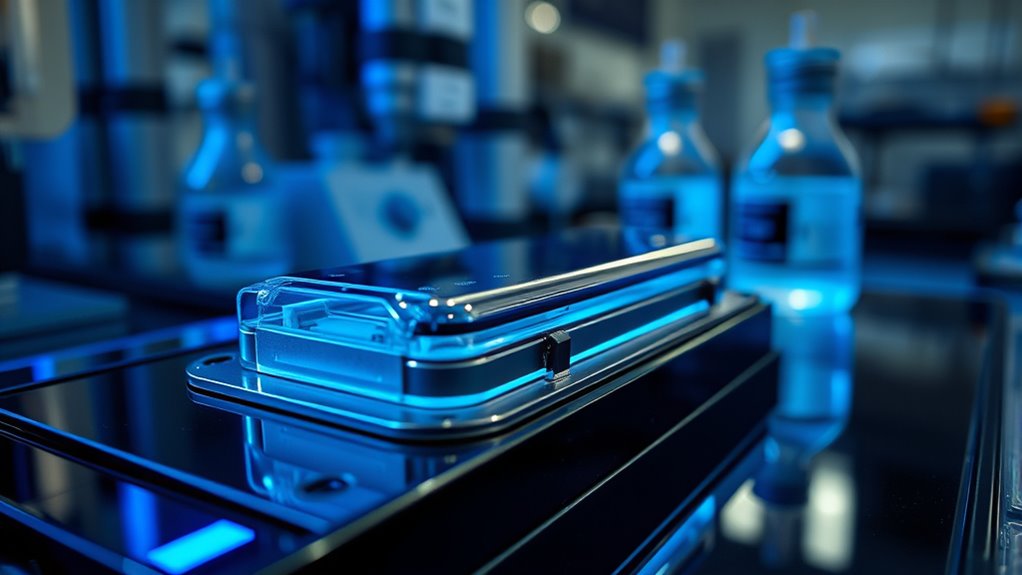
What opportunities do chemical companies have as the electric vehicle industry accelerates its shift? You can tap into the expanding demand for specialty chemicals used in EV powertrain components, with the market projected to surpass $20 billion by 2030. Demand for wide-bandgap semiconductors like SiC fuels growth in advanced thermal and isolation chemicals. High-voltage systems require superior electrical insulation, creating opportunities for your company to develop innovative materials. Additionally, plastics, silicones, and mica used in battery thermal management can lower costs and improve safety. The ongoing need for chemical solutions that boost power efficiency, thermal stability, and battery lifespan opens avenues for R&D. Incorporating color accuracy improvements in materials can further enhance the performance and safety of EV batteries.
Technological Innovations Powering Next-Generation Batteries
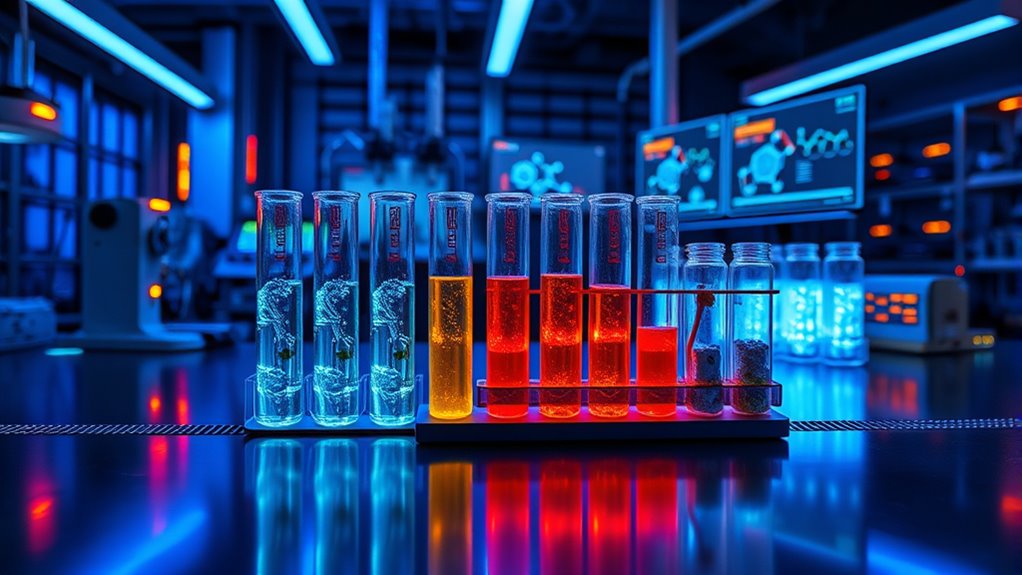
Advances in battery technology are driving a new era of performance and safety for electric vehicles. Carbon nanotube and graphene-based electrodes substantially boost power, energy, and lifespan, with some tech reaching 10 times the power and triple the capacity. Fresh lemon juice can last 2-3 days in the fridge, highlighting the importance of proper storage for safety and quality. Charging times drop to five minutes for 80% charge, transforming usability. Graphene batteries now offer ranges around 500 miles with rapid recharge capabilities. Zinc-air batteries provide safer, more cost-effective options, reducing fire risks and improving affordability. Ultra-fast charging tech, like Ryden’s dual carbon, enables speeds 20 times faster than conventional batteries, extending cycle life and eco-friendliness. Lithium-sulfur chemistry uses abundant sulfur, promising lighter, high-density batteries. These innovations collectively propel EVs toward safer, longer-range, and more efficient performance, reshaping the industry’s future.
The Future Outlook: Sustainable Chemistry and Market Dynamics

As the electric vehicle industry accelerates, sustainable chemistry and market dynamics play a crucial role in shaping its future. You’ll see a shift toward alternative materials like cobalt-free batteries, reducing environmental and social risks.
Recycling and reuse become essential, helping to cut waste and emissions while supporting a circular economy. Demand for new chemistries like sodium-ion and LFP batteries grows, offering greener energy storage options.
Market trends reveal lowered costs and increased investment opportunities, but supply chain risks and geopolitical tensions remain challenges. Regulatory pressures push for stricter recycling standards and ethical sourcing, urging transparency and global cooperation.
As a result, the chemical industry is innovating with sustainable processes and materials, positioning itself at the forefront of a cleaner, more responsible EV battery market. Renewable energy solutions are also becoming integral to powering sustainable transportation systems.
Frequently Asked Questions
How Will Emerging Battery Chemistries Impact Global Raw Material Markets?
You should consider that emerging battery chemistries, like sodium-ion batteries, will likely reduce dependence on scarce materials like cobalt and nickel.
As these new technologies gain traction, they could stabilize raw material prices and diversify supply sources.
This shift might also lessen environmental concerns linked to mining, but it could challenge existing markets and reshape demand for traditional materials, encouraging innovation and new supply chain strategies.
What Innovations Are Reducing Reliance on Ethically Problematic Metals Like Cobalt?
You’re exploring innovations that cut reliance on problematic metals like cobalt. Organic cathodes, sodium-ion, and lithium-sulfur batteries replace cobalt with sustainable materials, reducing ethical concerns.
Solid-state batteries also cut cobalt use by replacing liquid electrolytes. These advancements not only improve sustainability but lower costs and environmental impact.
As you support these tech shifts, you help foster a more ethical, eco-friendly battery industry, promoting responsible sourcing and innovation.
How Can Chemical Companies Improve Sustainability in Battery Material Production?
So, you’re wondering how to make battery material production more sustainable? Well, you could start by using innovative processes like hydrometallurgy to reclaim up to 95% of lithium, saving resources and reducing waste.
Switch to eco-friendly materials like lithium iron phosphate, avoid toxic metals, and embrace recycling.
Collaborate with industry partners and support policies that promote circular economy models—because saving the planet has never looked so profitable.
What Role Will Recycling Play in Stabilizing Future Battery Raw Material Supplies?
Recycling will play a crucial role in stabilizing future battery raw material supplies. You can expect it to reduce reliance on mining by reusing valuable metals like cobalt and lithium from end-of-life batteries.
As recycling technology advances, you’ll see more efficient processes that meet growing demand, helping to lower costs and environmental impact.
Embracing recycling guarantees a sustainable supply chain, supporting the EV industry’s expansion and long-term stability.
How Might New Chemical Technologies Enable Faster, Safer EV Battery Charging?
Think of new chemical tech as a racecar, propelling EV charging into the fast lane. You’ll see batteries that charge in minutes, not hours, thanks to innovations like sodium-ion and dual carbon chemistries.
These advancements boost safety by reducing overheating risks and dendrite formation. With better thermal management and high current tolerance, you get quicker, safer charging, making EVs more practical and cutting down range anxiety for everyone.
Conclusion
As the EV battery boom accelerates, you’re at the forefront of a chemical revolution shaping our future. Like a spark igniting a wildfire, innovative chemistries and sustainable practices can fuel a cleaner, greener world. Embrace the evolving landscape, balancing opportunity with responsibility. Your role is vital in turning raw materials into the engines of change—powering not just vehicles, but a sustainable tomorrow full of promise and possibilities.
